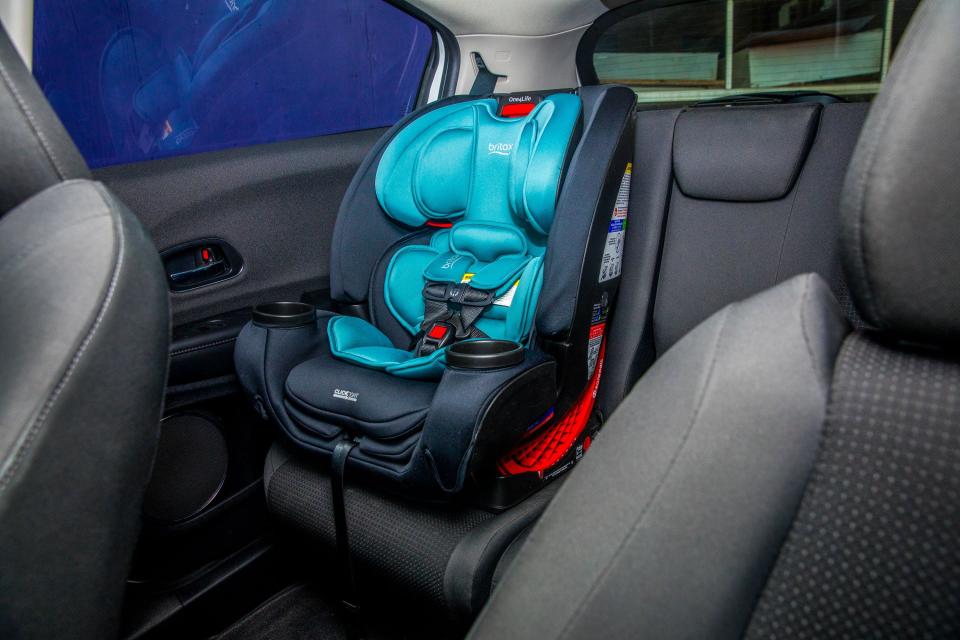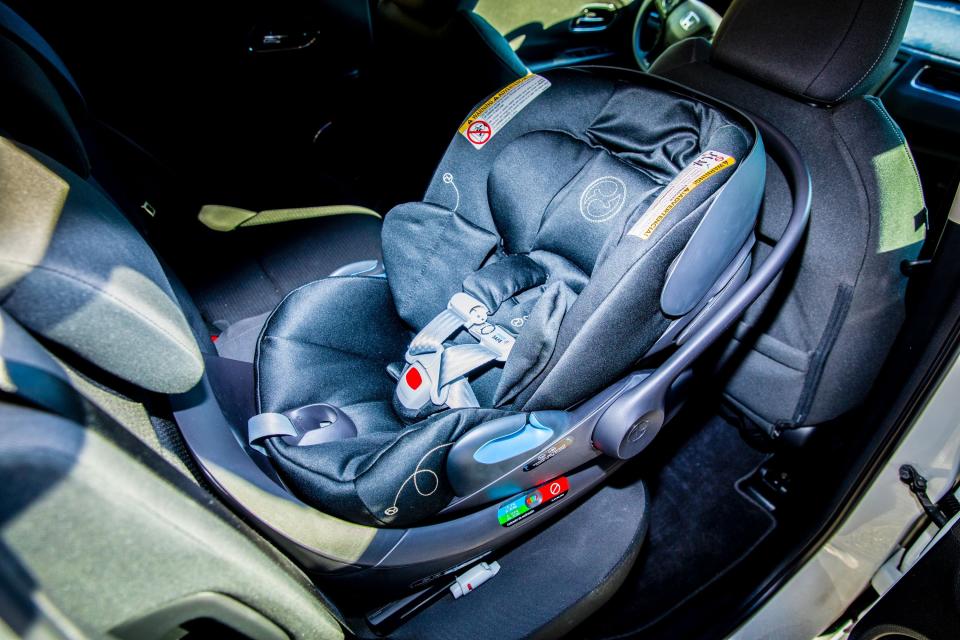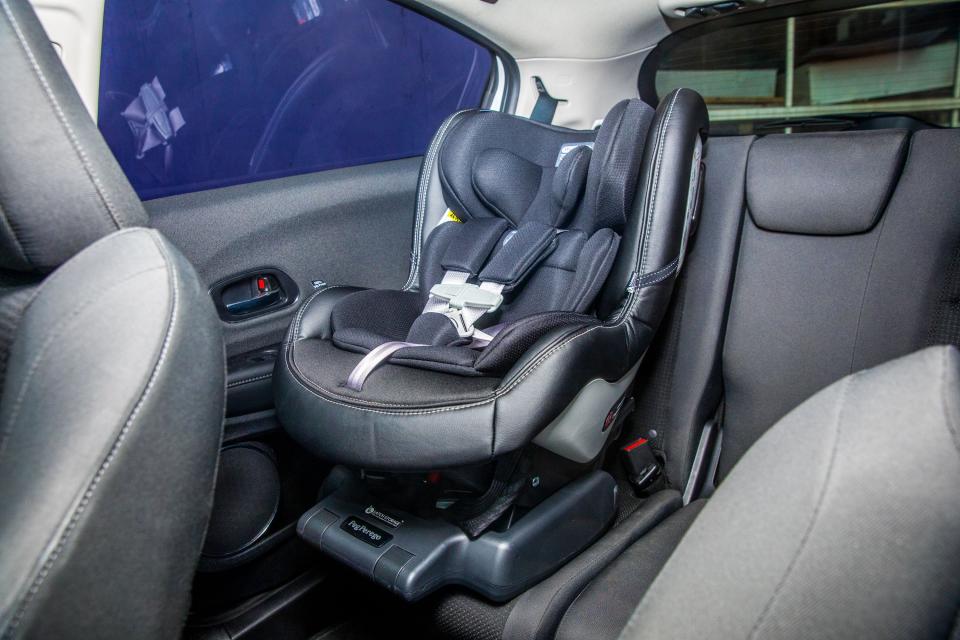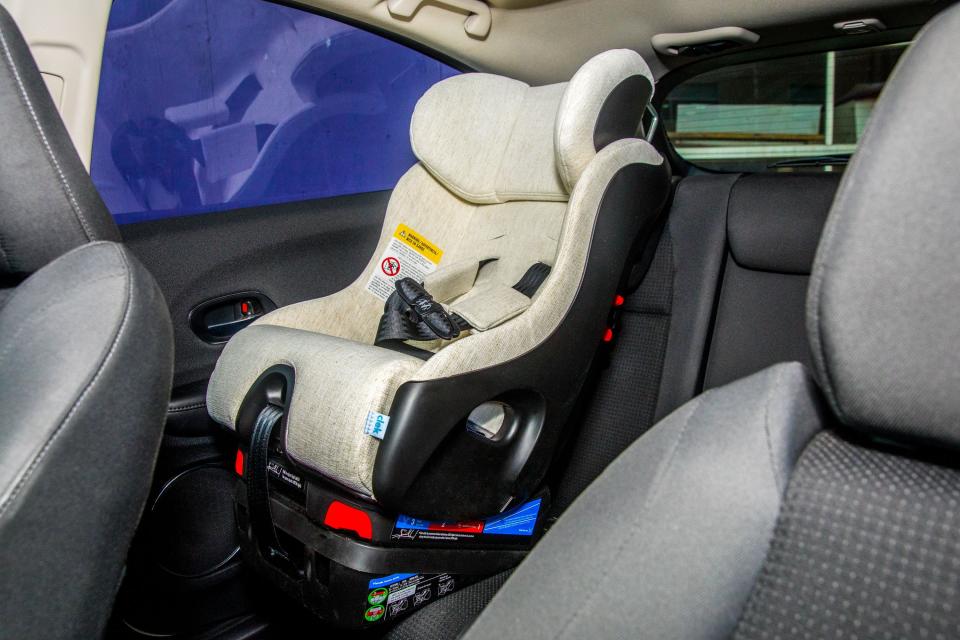I and My Testing Crew of Parents Have Used Dozens of Car Seats. These Are the Best.

"Hearst Magazines and Yahoo may earn commission or revenue on some items through these links."
There are popular car seats out there, but it’s hard to know which are the best. You might be tempted to rely on word-of-mouth advice when deciding on the right products for your precious baby, but after looking into the specs of different car seat models, you might form your own opinion.
When choosing the best car seat for your family, first consider safety. Then, when you’ve narrowed it down to the safest options in each category, you can have fun with other details, like the ease of use, style, price, and the ability to clean and keep the car seat fresh — especially if you’re opting for anything other than an infant car seat because you’ll be getting years of use out of it.
We broke down everything you need, tested dozens of car seats, and found the very best options for you. Yes, it’s a lot of information, but we promise, it’s all critical.
The Best Car Seats of 2024
Best Overall: Britax One4Life
Best New Car Seat: Chicco Fit360
Best Infant Seat: Cybex Cloud G Lux Extend
Best Convertible Car Seat: Peg Perego Primo Viaggio Kinetic
Best Rotating Car Seat: Evenflo Revolve 360 Extend
Car Seat Types
There are a several different types of car seats to choose from: infant, convertible, rotating, toddler, and booster.
? Infant
This is the category in the car seat world where you’ll find the model designed to take newborn babies home from the hospital. Infant car seats are rear-facing and designed to keep newborns safe. While some parents choose to start with the convertible car seat and use it in infant mode, other parents choose to have an infant car seat first and then switch to the convertible option when the baby grows out of it.
The cool thing about an infant car seat is that you can easily take it right out of the car with your sleeping newborn resting inside, detaching the seat from the base. We can’t promise a good nap transfer, though. There are plenty of stroller and car seat combos (aka travel systems) that make this transition seamless. One more thing: By the time your baby hits 12 months, the safest thing to do is transition to a convertible car seat.
→ Read More: 6 Best Infant Car Seats for Your Littlest Baby
? Convertible
Most convertible seats are good from birth until your kid is about 4 or 5. Others max out at about 10. It just depends on the make and model. They have extendable footrests while rear-facing but can face forward when your child grows out of that stage. Usually, you can leave the seat rear-facing until a child is around 35-40 pounds.
→ Read More: The 7 Best Convertible Car Seats for a Happy Baby
? Rotating Car Seats
This is the newest style of car seat, and it’s hugely popular. Rotating car seats have a mechanism in the base that allows them to swivel. This allows you to spin it toward the door to get kids in and out of the car seat with greater ease, then rotate it back so they’re facing forward or back as you drive. Like all car seats, you can use these without the base and install them with shoulder straps, but that obviously takes away what makes them special. There are several types of rotating car seats, but rear-facing convertible are the most popular.
These car seats are some of the heaviest, and they do take up quite a bit of space, so they’re not going to work for everyone. They also can rub against the seats in ways that other car seats do not, causing more wear to the car seat itself.
→ Read More: The 7 Best Rotating Car Seats For Maximum Convenience
? Toddler to Backless Booster
When your baby becomes a preschool-age toddler and has absolutely maxed out the rear-facing limits of their seat, it’s time for a forward-facing seat. In the toddler category, 3-in-1 car seats are popular, though the models differ. The idea is that the car seat is safe for babies and tots, but it can then transform into a booster. (Sounds pretty “convertible,” right?) These 3-in-1 (or all-in-one) seats are perfect for toddlers, but they might also include infant and rear-facing capabilities. However, all 3-in-1 car seats offer a booster option, which is where they differ from convertible car seats.
→ Read More: The 7 Best Toddler Car Seats You Can Trust
What to Consider
A lot goes into choosing a car seat, from how long you plan on using it to how easy it is to get into your car. There is truly no one-size-fits-all in this category. Several important aspects and considerations can guide your decision-making: how long you plan to use it, the size of your backseat and number of car seats you need to accommodate, what the safety features look like, how easy it is to install, if you need to use it for more than one car, and price.
Duration of Use/Height and Weight Requirements
Infant car seats are only good for the first year or so of your child’s life, but are popular choices because of convenience. They generally will accommodate your baby until they’re 30-32 inches tall and around 30 pounds.
If you’re planning on getting just one car seat and using it for several years — perhaps even as long as your child needs one — look for a car seat that can be both rear and forward-facing, with higher weight and height limits.
Size of Seat and Number of Seats Needed
Some car seats are simply massive, especially if they’re rotating models like the Evenflo Revolve. With rotating car seats, I always tell parents to give it 10 more inches of clearance than you think just to accommodate the revolving. You’re likely not getting more than two in a row, and it totally eliminates the middle seat. Seats like the Clek Foonf, however, are slim enough that you can fit three across even in a sedan, making them perfect for big families.
Safety Features
In the past decade, we’ve seen huge improvements in the safety of car seats. Innovations like the load leg that you see in the Cybex Cloud G Lux, our pick for the best infant seat, to Britax’s user-friendly tech that helps parents install the seat properly. Every car seat on this list has a variety of failsafes and safety features that makes it stand out from the competition.
Installation
Installation is by far the biggest pain when it comes to car seats. Some of them, like the Britax and Chicco, are designed to be especially simple and easy to do. The Clek and Cybex are straightforward for pros and seasoned parents (like *ahem* me), but may take a bit more scholarly studying of the guide for most people. Having bubble indicators and easy-to-operate latch systems can make the difference between frustration and contentment.
Portability
If you need to move the car seat between more than one car, you will need to buy multiple bases for infant and rotating car seats, or you’ll need a super-easy install for convertible and booster seats. Thankfully, toddler and backless boosters are easy as pie, and honestly so are infant and rotating seats if you have bases installed in multiple cars, but that is an extra cost consideration.
Price
If price is a main factor for you in your decision, it’s worth noting that convertible car seats are the most expensive because they last the longest. They have all the safety and comfort features found in an infant seat, and yet they extend long beyond the range of the carrier-style infant car seat. Convertible seats typically feature the most bells and whistles, too, especially our posher picks on this list. Things like a one-handed headrest extension and swiveling base add to the price of these seats, but trust us — they’re worth it. They last for years of your child’s growth, and they’re quite an economical purchase when you consider how long you’ll be using it. And if you have more than one child, even better.
How We Test
We at Best Products tested all the car seats on this list (and more), putting our children in them. We got down and dirty, literally smothering them in pudding and potato chip crumbs to test how easy they are to clean. We reviewed safety data from the National Highway Traffic and Safety Administration (NHTSA) and Consumer Reports to determine the performance of these seats in collision conditions. We spoke to manufacturers to learn about their design and engineering, getting nerdy with them.
We used each car seat for over 40 hours in multiple cars. We tested with sedans, full-size SUVs, compact SUVs, and the ever-luxurious minivan. (Why do they become so alluring?) We tested the infant seats with newborns and babies about to reach the end of the height and weight limits. We tested the convertible car seats with kids ranging from a cool 7 pounds up to over 100. Each one saw use and abuse to make sure that we found the best of the best. After testing dozens over the years, these are them.
Our Full Car Seat Reviews

If you are planning on buying one car seat, and one car seat only, the Britax One4Life offers the most options. It’s designed to be used from birth until your child no longer requires a car seat.
The ClickTight feature on this car seat model ensures a safe and secure installation every single time, which is incredibly important because so many parents unknowingly install car seats incorrectly. Rest assured knowing that everyone from dads to grandmas can nail a rock-solid installation, even when you’re not around. This car seat can work with a latch or belt path, but Britax designed it so that the belt path isn’t just convenient but every bit as safe as the traditional latch method.
We love that the car seat features SafeCell Impact Protection to absorb extra energy and protect the baby beyond federal standards. This is a combination of roll bars, hexagonal-shaped impact cells made of flexible plastic, and their reinforced steel bars. It also has this super groovy v-shaped tether that acts as even more impact disbursement.
One of the easiest-to-adjust car seats out there, the One4Life boasts a 15-position headrest and a nine-position recline with a bubble-leveling indicator. All of the fabrics are machine wash and dry and not too tricky to remove or replace. Though the dishwasher-safe cup holders can hide gunk, this is true for any small space a child has access to. We had an incident testing this car seat with a hidden handful of Passover gummies, and a particularly warm spring day. By the time we got back to the car seat, it was one giant gummy. Cleaning it wasn’t fun, but thanks to simple style and washable fabrics, it didn’t ruin anything permanently.

The Chicco Fit360 rotating car seat is my favorite new car seat that I’ve tested this year. Not only is it convertible, but it has a decent upper weight limit of 65 pounds, and it rotates in any position. It’s easy to clean with all machine-washable fabrics, and the mesh seating means that your baby isn’t going to get all swampy on warm days or when wearing a lot of blankets.
Of all the rotating car seats I’ve tested (basically all of them), this is by far the easiest to install and rotate. It uses the belt of the car seat, threading it through a belt path, and it does so in a way that once you learn it, you’ll never mess it up on any shift between cars. Another impressive note is the density of the padding around the head. It feels like a slightly denser memory foam mattress, and it surrounds the steel framing, providing superior impact protection on the sides.
It is large and in-charge, though. There’s no way you can get more than two of these in a row, and if you have one on either side, no one is sitting in the middle seat. But for the pure convenience of this car seat, it cannot be beaten.

Infant car seats aren’t only for riding in cars, they also end up as a place you put your child when you need them to be contained when you’re at home or out and about. (Though they are not meant for overnight sleeping.) The Cloud G Lux by Cybex has a 12-position adjustable headrest and an adjustable, extendable footrest for greater comfort and longer use.
Impressively, this isn’t even our favorite part of the Cloud. It has a rigid latch system that takes only seconds to install, and the car seat has both an anti-rebound bar and a load leg that works to disperse impact during a crash. The load leg significantly reduces the force on the baby’s head and neck, protecting the brain and spinal column, and the anti-rebound bar, which is on the opposite side, provides that same support as the car shifts back on the rebound of the impact.
If you’re installing the car seat without the base, the European belt path that has the shoulder strap wrapped around the back of the seat provides the infant seat with more stability. And Cybex installed Sensorsafe technology, which is a device at the chest clip that connects to an app on your phone that tells you if your baby has been left behind in the car, if they’ve been in the seat too long, if the clip has come undone, and more. Yes, we found that you can and will get false alarms, but we’ve never seen a case when it didn’t alarm the parent if their child had escaped or was seated too long. More alerts is far better than fewer in this instance, even if they get irritating.
The UPF 50+ rated canopy does a spectacular job of keeping the sunlight from making your baby extra crispy in the sun thanks to how oversized it is, and the ventilation works to keep them as cool as possible. And when baby mucks it up? It’s machine-washable.

Do you have a tall baby? The Peg Perego Primo Viaggio Kinetic makes keeping them rear-facing more comfortable. It was crafted to keep kids rear-facing as long as possible, and since more and more states (like our state of New York) require babies to be rear-facing for at least the first two years, I expect the Primo to be a popular pick. With an astonishing 47-inch height limit and deep seat, it’s one of the biggest in its class.
The Primo Viaggio Kinetic has tons of safety features, from its anti-rebound bar to its proprietary kinetic pods that help distribute the impact during side-impact collisions. The seat utilizes two types of foam that work together to keep babies comfortable and as safe as possible. The 10-position headrest is easy to adjust, and the simple style of the latch makes the seat easy to install. If you’re installing the seat without the latch, like the Cybex, the Primo has a European belt path that provides additional support in the event of a crash. And also like the Cybex, the fabrics are machine-washable.
We particularly love how high the kids sit when they’re in this chair. It allows them to see straight out the rear window of windshield, cutting down on car sickness. We also love softness of the fabric and the fact that the seams are more integrated and less exposed, which our sensory-sensitive kids appreciated greatly.

The Evenflo Revolve 360 Extend fixes one of the biggest complaints we hear about rotating car seats — that they only work in rear-facing mode. The Evenflo revolves in every mode, making it as easy to strap in your 6-month-old as it is your 4-year-old. Given that it’s an extended rear-facing seat with a 50-pound weight limit in rear-facing mode, and over a 100-pound limit in forward-facing mode, you’ll be grateful for the turn, and so will your back.
The rotation is a wonder when your child is wiggly and squiggly, but also when you have to pull off the zip-off fabric because they’ve gotten car sick and it’s super gross. It’s also machine-washable and can go in the dryer, and we were immensely grateful for that. Immensely. As noted above, some of our testers get carsick, and it’s an unpleasant cleaning job.
As far as safety mechanisms go, the Evenflo Revolve is no slouch. Like the Cybex Cloud, it too has Sensorsafe available. The entire frame is steel-reinforced, which does make it a bit on the heavy side, but provides superior protection. You can install the base with either a latch or a belt, so no matter your car, if it fits behind the seat, you can use it.

The Clek is a tank. Full stop. It is consistently lauded as one of the safest car seats on the market, and is a wonderful example of the brand’s commitment to children’s safety. First off, it has crumple-zone technology and its patented React energy-management system that acts like the inner lining of an eggshell (which keeps the yolk from breaking) and distributes force during a frontal impact. It is designed to crumple around the child evenly, protecting the kid at the expense of the seat. The steel anti-rebound bar reduces seat movement, which helps protect the baby’s brain and spine. The advanced side-impact protection, with deep side wings and energy-absorbing expanded polypropylene (EPP) foam layers, helps keep your child safe in a side-impact crash. And the rigid latch makes the installation nearly foolproof.
This is the only car seat on this list with fabrics that aren’t machine-washable, but they are stain-resistant and will withstand pretty vigorous scrubbing, according to our testing. This is one of the harder seats to install, in our opinion, and getting the cover off to clean the shell is kind of a pain. But for the transparent safety of the seat, we think it’s worth it.

Boosters can be hard to choose because kids often find them too confining or too hard to sit on. The Nuna AACE combines a thicker cushion with expanding side wings to make the seat a luxury item for your child. No longer will long rides be filled with complaining about the comfort of the seat. They’ll just be complaining about being on a long car ride, period. It has eight positions of recline and 10 headrest positions that automatically adjust the side wings when raised or lowered. The seat has three different depths to keep their legs not only comfortable but appropriately positioned.
It connects via a simple rigid latch, and for the highback booster and regular booster, there’s a belt positioner with a color guide that shows your child how to buckle in properly. The fabric is machine-washable, but this is for the age of kids where most messes can be wiped off.
How to Clean a Car Seat
Cleaning a car seat can feel like a chore, but it doesn’t have to — if you know how to do it right. Make sure to reference your seat’s instructions, because each one is slightly different. One universal truth is that straps cannot be machine-washed, so you just need to use a damp cloth and wipe those off.
Get rid of the little things first. First, use a handheld vacuum to remove dirt, crumbs, and anything else icky from the car seat.
Spot clean spills. Even perfect tots have spills. Use a carpet cleaning solution to spot clean any stains. For tougher spots, use an inexpensive degreaser and simply pour it on the stain to watch it magically erase it. Then, use a washcloth with water to dab up the degreaser so the chemicals don’t sit.
Freshen it up. Dip a cotton towel into a solution of water and baby-safe laundry detergent and wash the car seat down. Let it air dry outside. Voilà!
Machine wash: Some of the seats have machine-washable covers. Just follow your manufacturer’s instructions and get that bad boy cleaned right up.
Proper Installation
The safest car seats are the ones that are installed properly. However, a 2016 National Highway Traffic Safety Administration (NHTSA) report from 2016 found that more than half of all car seats are installed incorrectly.
Making things even trickier for parents, laws vary from state to state regarding the proper car seat position for your baby, based on your baby’s growth stage. You’ll need to brush up on the laws where you live and study if you’re planning a road trip. You’ll also want to register that car seat so that in the event of any recalls, you’ll know immediately.
Signs Your Car Seat Is Installed Incorrectly
The car seat harness is too loose. Sure, you don’t want your little one to be uncomfortable during a long ride, but it’s crucial to make sure the harness is in the correct position and not too loose. If you can place more than two fingers between your little one and the harness, it needs to be tightened.
Your baby is forward-facing. Until your baby is at least age 2, but preferably as long as they fit the height and weight limits, your little one should ride rear-facing.
The car seat base isn’t secure. Make sure when you initially install the car seat that you push down with all your weight to ensure the base is secure and snug in your backseat. The fix? Loosen up the seatbelt to reset the base into the backseat and tighten the seatbelt again.
The seatbelt looks funky. It’s true — correct seatbelt routing is less intuitive than you’d want it to be, but the main thing is to make sure you follow the guidelines in the manual exactly. Keep an eye out for stickers on the seat itself that indicate where the seatbelt should be positioned. The chest strap closures should be nipple level, and the crotch strap should be secure to the body. There should be no more than two fingers of space between the strap and your baby. And remember, your baby should not wear a winter coat under the straps — a thin jacket under and blankets atop.
The leveling indicators are off: Most car seats now come with some type of leveling or installation indicator. Whether it’s a bubble level or a guide on the side of the seat, it’s important to make a note of where it should be according to the manual and where your car seat is.
You Might Also Like